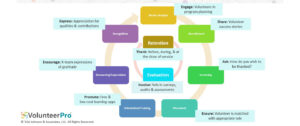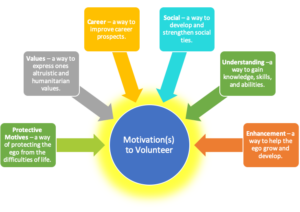
5 Key Factors in Creating a Program That Will Attract Volunteers
You’ve probably tried multiple strategies to attract volunteers.
To maintain a steady pipeline of volunteer talent, we’ve also suggested a number of effective recruitment methods, improvements for your recruitment page, and ways to gain traction with your messaging.
And when you are actively focused on recruiting for available opportunities, each of those has their place.
What about the possible impacts on other tasks your position has you responsible for?
Can they help improve your outcomes?
Indeed, they can!
The work you do to manage your ongoing volunteer operations can do double duty, helping you manage a highly functional team and also continue to support your ability to scale.
For two clear reasons:
1) Well-run volunteer programs tend to retain more talent, reducing the need to continue to fill that pipeline and decreasing the burden for volunteer recruiters
2) Effectively managed teams often also result in greater volunteer satisfaction and thus increased word-of-mouth marketing. When volunteers sing your praises, you don’t have to.
Further, there are some foundational aspects of a volunteer program that can make it inherently more appealing to the right prospects.
The good news is that you likely have many of them in place.
The next step is to understand how they can be more effectively leveraged in your recruitment to make your program even more irresistible. In this blog post, we’ll outline five areas to evaluate and focus on.
#1 Using the Volunteer Life Cycle to Attract Volunteers
The volunteer engagement lifecycle illustrates practices that foster the growth and development of volunteers who serve from before service until they eventually leave. In addition, how you communicate about the phases in the volunteer lifecycle can also be used to fuel the effectiveness of your program’s appeals.
When prospective volunteers understand how well you are prepared to make the most of their time, the more likely they will be to give you an enthusiastic “yes!”
The Phases of the Volunteer Lifecycle

Needs Analysis
In the needs analysis stage, you determine volunteer roles and how they will meet the organization’s to meet its goals.
Here is where the frameworks for captivating position descriptions take form.
However, you’re also looking at what infrastructure is needed to support and motivate volunteers. This stage is where you begin to delve into the risks of volunteer involvement and how the organization plans to mitigate them.
Having these details well in hand gives your program and organization credibility in the eyes of prospective volunteers making your organization a preferred choice to discerning community members.
Recruitment
While this stage is an obvious one to review in terms of improving your pipeline of candidates, there are some specific areas to address.
Specifically, in this stage it is helpful to define who your target audience is. By better understanding who your ideal volunteers is, you can focus your messaging and strategy to reach that person directly.
You’ll want this refined down for each type of volunteer opportunity. The more closely you can pinpoint the ideal candidate, the easier it will be to know what messaging and channels of communication are most likely to reach them.
By targeting your ideal volunteer, you can also consider who they encounter in their daily lives. So, planning for recruitment should include what strategies or partnerships can be leveraged to continually show up on your ideal candidates’ radar. The more you appear in front of the right people, the more right people will show up when you need them.
Screening
When screening volunteers, you should be assessing what the minimum requirements are and whether your candidate meets, or can be trained to meet, them.
This is also a time to communicate with future volunteers that you offer flexible options for needed roles and to see if there is a fit between your needs and their availability and capabilities.
Finally, this is a good time to find out what motivates the candidate to participate. Not only can this help determine a suitable role but, through two-way conversation, you can strengthen your ability to convert that prospect into active volunteers.
Learn more about volunteer interview questions with our Cheat Sheet on the 10 best to ask.
Placement
Determine what role the volunteer will be assigned and that it suits their expectations as to timing and length of commitment.
Here, too, is where they should learn who will provide them day-to-day support, when they’ll start, and what they need to know to get started.
Offering added clarity to the recruitment process gives your volunteer a firm foundation, reassuring them that the organization is prepared to meet their needs.
Orientation/Training
Your volunteers should be welcomed to the team with an agenda for their training and orientation plan. Part of the groundwork of a program that will attract volunteers is planning for an exceptional onboarding sequence.
An organized approach to delivering training and establishing expectations gives the relationship between your volunteer and your program a strong start.
It is also a great time to encourage volunteers to tell a friend about your volunteer openings.
Resourcing/Supervision
This stage is the day-to-day maintenance of the relationship between the volunteer and their role. It includes making sure minimum requirements and expectations are being met and monitoring that the work stays within the scope of the role.
Consistent reinforcement of policies and procedures helps build trust in the program and empowers volunteers to take claim of their work without the distraction uncertainty can bring.
During this period, mutual respect and active conflict resolution are key. When volunteers feel seen and heard, they are more likely to stay. In addition, now is a great time to ask for personal endorsement and testimonials that you can use to attract new volunteers.
Recognition
Recognition is also a day-to-day responsibility. It encompasses how the team leader or supervisor offers support to volunteers.
It is vital to strategize the ways individual volunteers and teams will be recognized and thanked on an ongoing basis, as well as acknowledging specific achievements and growth.
Giving volunteers goals to aim for aids in retaining motivated supporters.
In addition, photos taken during recognition events are also an excellent source of images that can be used in marketing to pique the interest of future volunteers. Just make sure you get permission to share them.
Retention
More an outcome than a stage, retention has a lot to do with addressing issues volunteers face. There should be clear channels for offering feedback and suggestions and how complaints will be resolved.
It also is where you assess what’s working and how to do more of it to improve the volunteer experience.
If you enjoy high retention rates, this is something to share with others who are considering a volunteer position with you. If many volunteers have long tenures, it most likely indicates that their experience is meaningful.
Evaluation
During this phase, you ensure the ongoing quality of volunteer work and determine how will you track volunteer satisfaction over time.
Also, it is a time to assess and identify program gaps and report your program goals and achievements.
Reporting out to the general public your progress toward organizational and community goals also maintains a level of transparency that encourages trust.
Your volunteers will have joined your program in part because they believe in your mission. A successful volunteer program reflects the mission, vision and values of the larger organization.
Your work on the fundamental phases of the volunteer lifecycle also helps you maintain a strong organizational culture and identity.
Your volunteer program should embody these values in its administration of volunteer supervision and support. You can also actively communicate how these same aspirations and beliefs align with your mission to the public at large.
A volunteer experience that is congruent with the mission and values both attracts volunteers to service and reaffirms the participant’s commitment.
#2 Structure
The structure of your volunteer program will also have an impact on which candidates might be the best suited. The ability to clearly articulate the format your program takes can help a potential candidate see where they fit.
You may not specifically state “we’re an Independent In-House Volunteer Program” but, you can use language, pictures and stories that tell how the program works in relation to the organization and its mission.
There are four basic program structures. Keep in mind which definition most closely aligns with your arrangement and plan how you can describe it in succinct, clear terms.
Volunteer prospects want to know whether they’ll be working in one segment of an agency or across many, whether they’ll be near the inner circle of an organization or a focused external team.
Independent In-House Volunteer Programs
These programs operate within the same parent agency but, do so independently from one other. Programs may share or cross-refer volunteers.
Pros:
-
- Programs can share and refer volunteers internally instead of losing them to outside organizations
- Volunteers identify with high-profile programs
- Direct link between volunteer recruiters and program staff
Cons:
-
- Internal competition for scarce resources
- Roles for volunteer applicants limited to what’s available within the program
- Mixed messages about volunteering at organization
Volunteer In-sourcing
Volunteer programs that work through a centralized volunteer administration office at their agency, which recruits and places volunteers in positions throughout the agency.
Pros:
-
- Economies-of-scale realized through shared volunteer recruitment and management function
- Ability to offer a variety of roles to volunteer applicants
- Ability to streamline volunteer orientation and training function
Cons:
-
- Additional communication required between programs and volunteer office
- Volunteer office may lose touch with emerging program needs
Volunteer Out-sourcing
Volunteer programs that collaborate with a volunteer intermediary organization —such as a volunteer center, RSVP program, or United Way —to recruit and place volunteers for specific positions.
Pros:
-
- Economies-of-scale realized through shared volunteer recruitment function
- Greater community awareness if intermediary is well-regarded and known in community
- Potential for better match with volunteers who are highly identified with cause due to increased options
Cons:
-
- Issues of accountability for quality of volunteer screening and placement
- Smaller programs may receive fewer referrals
- Increased competition due to increased choice of options
Autonomous Volunteer Teams
Volunteer teams that are supported by the parent organization, but whose structure and administration may be led and managed by the volunteers themselves. The level of independence is determined by the agency and may vary from team to team.
Pros:
-
- Facilitates shared leadership and ownership at volunteer level
- Volunteers can design activities that are highly motivational to them
- Ability to cultivate volunteer leadership from within organization
- Good model for involvement of highly-skilled volunteers
Cons:
-
- Recruitment and coordination depends on level of volunteer skill
- Possibility of misalignment of team activity and agency goals
- Potential for loss of momentum
While your explanation to the layperson will not likely use these terms, it does help to explain to future volunteers how tier work fits into the whole. Then, there are no surprises.
#3 Volunteer Satisfaction
To attract volunteers, it should be made obvious how participation leads to positive gains for volunteers themselves.
A role that clearly aligns with an individual’s motivations to serve will have automatic resonance and appeal. The support that’s provided to them once they’ve joined your program should continue serving those motivational needs.
Learn more about how to align your marketing with six volunteer motivations.
Organize training, feedback, and recognition to address the major categories of motivation in order to
support all aspects of volunteer satisfaction.
Six Key Volunteer Motivations

For consistent volunteer satisfaction, weaving these areas of focus into the fabric of your program should be a priority:
- Connecting organizational mission and personal values
- Providing opportunities to meaningfully serve others
- Teambuilding and occasions to socialize
- Recognition from highly respected peers
- Giving reassurance their tasks have value
- Offering emotionally supportive settings
- Furnishing quality in-service training
- Presenting a variety of assignments to explore
- Encouraging specific skills development and stretch projects
- Administering facilitated advancement and networking
- Fostering leadership development
- Keeping the experience positive & upbeat
- By prioritizing volunteer satisfaction with a well-run, volunteer effort, you will be more likely to generate positive word-of-mouth marketing and keep regular volunteers coming back for more.
#4 Volunteer Retention
There’s no question that a volunteer program staffed by a team of committed, enthusiastic volunteers will have a positive impact on attracting new volunteers. This is why it’s important to develop practices that nurture retention among supporters.
There are three primary factors that research has shown influence retention.
Person – Organization Fit
A volunteer will be drawn to serve an organization whose values and goals match their own beliefs. This is why it’s important to express the mission in recruitment materials.
Once the prospective candidate has expressed interest and is moving toward joining, there are actions you can take toward ensuring the person and organization are aligned:
-
- Ask in the interview about their interest and association with the mission
- Orient newcomers to the organization’s norms and values
Person – Task Fit
As committed as someone might be to the mission of an organization, performing tasks outside their areas of interests and talent could reduce their willingness to contribute. In developing the best fit between the person and tasks, your program should make sure to:
-
- Design meaningful volunteer jobs
- Clearly communicate the central and peripheral tasks expected of the role
- Match volunteers with tasks they enjoy and suit their capabilities
Managerial Treatment
A volunteer who feels valued and recognized is more likely to continue participating. Your program’s management can make strides in assuring that volunteers feel this way by:
-
- Maintaining transparency in decision-making about how the mission is realized
- Consistently reinforcing how volunteer actions contribute to the mission
- Expecting that long-term volunteers will have expectations more similar to long term employees
There may be a number of other factors at your organization that contribute to positive retention rates as well.
When you are able to communicate how these elements are satisfied, you also set the expectation volunteer applicants will take your opportunities seriously.
#5 Community Impact
There is no more powerful tool to attract supporters to your organization than showing, through every aspect of your volunteer program’s communication, that your volunteers are creating real community impact.
The best way to achieve this is by capturing the work that’s getting done in quantifiable data, as well as pictures and in stories. When your volunteer prospects hear and see the changes that have occurred for the populations you serve, as a direct result of volunteer service, it is some of the most compelling recruitment you can be doing.
Volunteers want to know their efforts can produce results.
Therefore, in order to create a consistent pipeline of volunteers, it is vital that you have data to show the positive results your program delivers.
So, take time to establish some metrics that prove progress is being achieved.
It might be pounds of food distributed, number of animals adopted, or the quantity of books that were read because of your volunteers’ efforts. You must establish metrics to demonstrate accomplishment and progress toward the goals of your mission.
As you can see, even your day-to-day volunteer program operations can have an impact on your ability to effectively attract volunteers. While it doesn’t replace volunteer marketing, managing an exceptional program can make your efforts much easier.







Leave A Comment